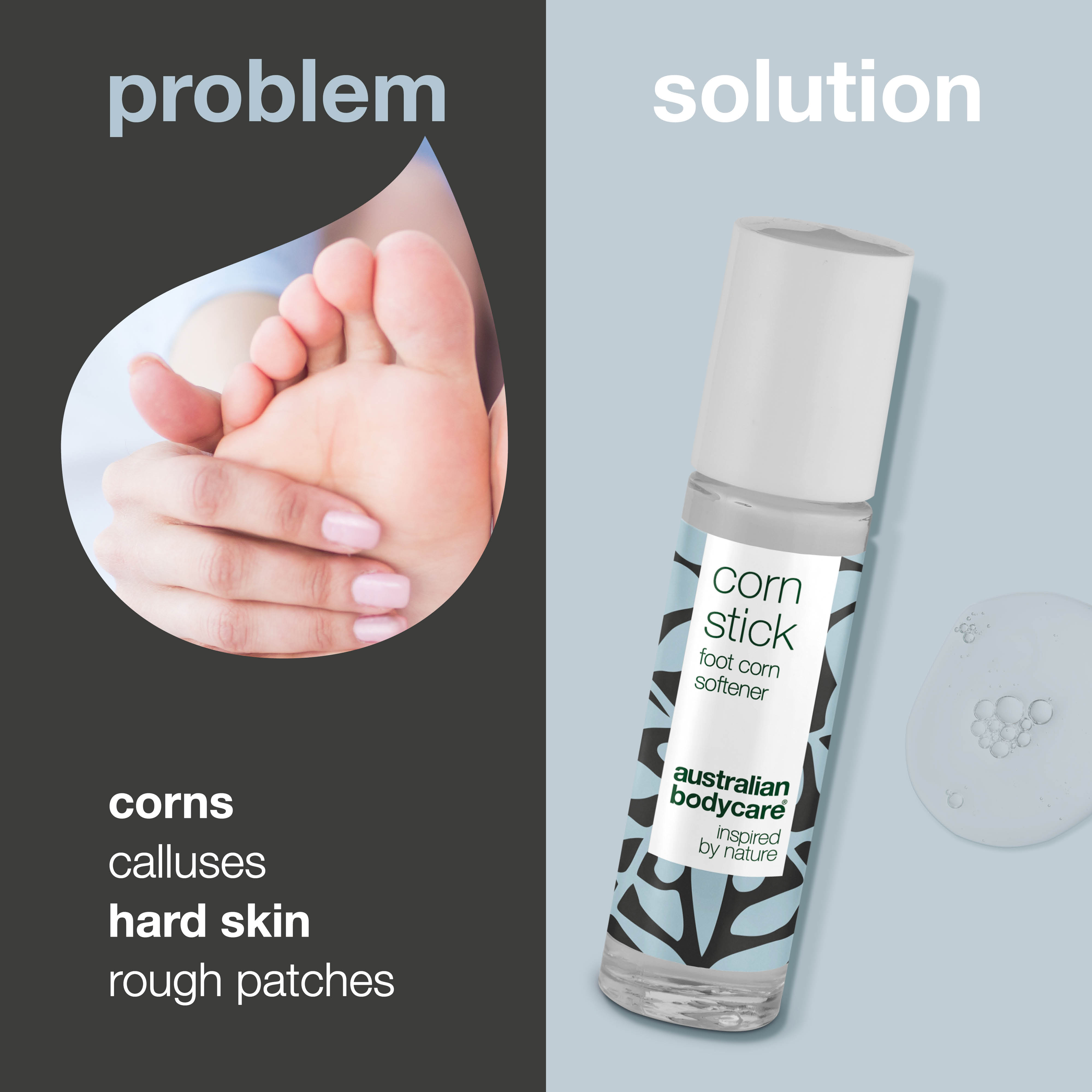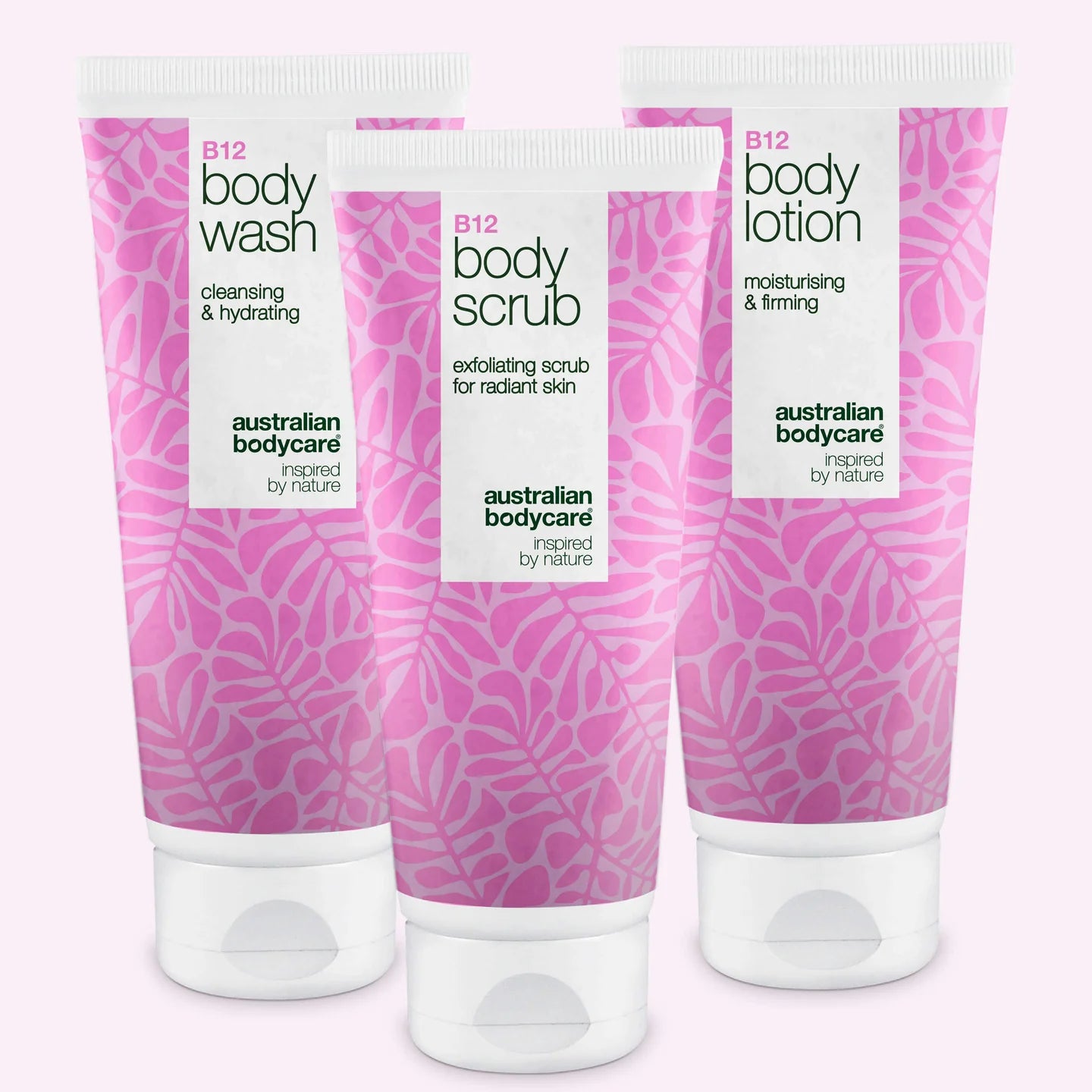Corns – How to remove calluses – 9 simple, but highly effective tips!
When the skin on the feet is subjected continuous pressure or rubbing, it reacts by forming hard skin, calluses and corns. Corns can be very painful, but fortunately there are effective treatments, and there is also a lot you can do to prevent new corns.
If you have ever had corns, you know how painful they can be. When the corns have been treated, you will promise yourself to look after your feet better in future. You can learn a lot here about treatment and prevention of corns.
Table of contents
Treatment for corns
Corns are very painful, and will rarely disappear by themselves without treatment. Fortunately, there are good chances that they can be treated, and it is advisable to start as soon as the corn appears, before it grows even larger.
Australian Bodycare has developed a Corn Remover containing Tea Tree Oil, which is effective for dry skin and cracks in the skin. It gives gentle, intensive skin care, and antibacterial. Use it up to four times a day, for example after a bath, or keep it on your bedside table and make it a habit to treat the corn just before you go to sleep.
Results after using a Corn Stick for 4 weeks


Good advice about removing corns:
- Soften and care for the skin with foot cream containing Australian Tea Tree Oil, which is good for hard and cracked skin. It is effective, but at the same time gentle on the skin.
- Take a foot bath and add a few drops of pure Tea Tree Oil in the water. It will help to dissolve calluses and corns, and at the same time it cleanses the skin.
- Rub the corn carefully with pumice stone (natural stone with abrasive effect) when you are in the bath or take a footbath. Your feet must be wet and softened before you use pumice.
- Use a Corn Stick from Australian Bodycare containing salicylic acid, which helps to dissolve the hard skin.
- Make an appointment with a podiatrist, who can remove the corn carefully by cutting it away. This is not painful – it hurts more if you leave the corn as it is.
- Use a protective corn pad, which provides immediate relief by easing the pressure on the corn. However, a corn pad is not a treatment for the corn.
- Buy a pair of insoles for your shoes, to serve as shock absorbers and take the strain from your feet.
- Remove whatever caused the corn to develop. Most often, this means looking at the shoes you wear, and if possible replacing them with a pair that fit your feet better.
A corn is an accumulation of hard, callused skin, and it is easiest to remove calluses and corns by softening the skin. You can do that by taking a footbath and using a good, nurturing cream on your feet. You obtain the best results by applying cream to your feet every day.
When you are in the bath or have your feet in a footbath, rub the corn and the callused skin carefully with a pumice stone. It does not damage the skin, but helps to remove the corn. On the other hand, you should not use a foot file, because the friction caused by filing the skin has the effect of heating up the skin, and it reacts by forming a new layer of hard skin.
How to treat corns between the toes
Corns between the toes are quite common; they are also called heloma molle or soft corns. They are often softer than corns in other places, but they are at least as painful, and should be treated as soon as they appear.
Corns between the toes are soft, because sweat and damp keep them soft. In the moist environment between the toes, corns can become infected, which it is important to avoid.
You can use a foot cream and corn remover from Australian Bodycare with Tea Tree Oil, which act against both the hard skin and the risk from bacteria, as Tea Tree Oil is antibacterial. The oil is also effective against the itching and irritation, that can easily start between the toes.
How to treat corns under the feet
Corns under the feet are hard corns, also called heloma durum. They hurt, and should be treated before they grow larger and become even more painful.
The best way to treat corns under the feet is to care for the feet and soften the skin with a good foot cream, together with a corn remover from Australian Bodycare, which is effective against dry and hard skin. For example you can use a cream that contains Tea Tree Oil. Additionally, you can rub the corn with a pumice stone when you take a bath or footbath.
You can also choose to use a corn plaster or a corn pen. If the corn has grown very large, it may be necessary to have it removed by a podiatrist, who can cut it away. Finally, you can buy a pair of insoles for your shoes, to serve as shock absorbers and take the strain from your feet. Try changing over to shoes that are more shock-absorbent and have more space for your feet.
Marie from Australian Bodycare explains about treatment for corns under your feet.
Why do people get corns?
Corns form when the skin is subjected to pressure or rubbing over a long period of time. The skin then forms hard layers or calluses, which are extra thick, horny skin. This hard skin on the surface forms to protect the underlying skin from damage. Corns are an accumulation of hard skin at one point.
The most frequent cause of corns is footwear. High-heeled shoes, and narrow, pointed shoes are the culprits behind many foot problems and numerous sore toes and feet. When shoes are too tight or too loose, or when they pinch the feet too much, they cause pressure and friction, and the skin form calluses and corns – to protect itself. Since especially women tend to go for shoes with more focus on design than comfort, it is especially women who suffer from corns.
Corns can form because you wear shoes that simply do not fit your feet, and your feet are then subjected to undue strain. Corns may also be due to irritation from stockings or socks that do not fit correctly.
What do corns look like?
Corns (a medical name is heloma durum) are small, hard patches on the skin that have gradually become so compressed that they are shaped like a thorn. Corns can occur anywhere on the feet, but typically appear where there is continual pressure or friction. This is around the heel, under the ball of the foot, and on the tips of the toes, or the sides, above or below. Most frequently affected are the big toe and the little toe.
Corns are usually due to shoes that pinch the feet too much or are too tight. Because many women have a fondness for high heels and narrow shoes with more focus on smart appearance than comfort, women tend to suffer from corns more often than men.
When normal skin is subjected to pressure or friction for long periods, it reacts by forming calluses (extra thick and hard skin) on the epidermis to protect the underlying dermis and subcutis layers from damage.
It is very painful to walk on this hardened lump of skin (the corn), or to wear shoes, because the corn presses on the nerves in the dermis.
The typical symptom of a corn is a small lump of hard skin. It is often round, with a hard centre, surrounded by tender skin, which is painful when the corn is pressed.
What is a corn?
If you feel something that hurts on your foot and looks unattractive, then you will be in no doubt that something is wrong. But it may be difficult to see whether it is a callus or a corn, and it may even look like a verruca.
When the skin is subjected to pressure or friction, it will react by forming a hard layer to protect the existing skin. If you do nothing about the hard skin, it may develop into a corn in some places. As a rule, hard skin develops on the parts of the feet that carry the weight of the body, i.e. the heels and the ball of the foot. Corns, on the other hand, usually appear in places subjected to pressure (from shoes). That is around the heel, under the ball of the foot and around the toes: on the tips, the sides, above or between the toes. While hard skin may cover a larger area, such as the whole of the heel, corns will be smaller and limited in size. Hard skin is seldom painful. Corns, on the other hand, are tender when pressed.
Precisely because a corn is small and clearly defined, it may resemble a verruca. Typically, a verruca will have tiny dark dots and a spongy surface – which you can see if you look carefully. While a corn is tender at the actual point where the centre is, the pain from a verruca will normally be felt over a larger area.
How can corns be prevented?
The best advice for avoiding corns is really to think about what you subject your feet to. We often think about caring for the rest of the body, but forget our feet, even though they have to carry us all the way through life.
More care and attention to feet would therefore make a big difference, and could save a lot of corns.
You can begin in the bath, where you can use a pumice stone to remove and prevent hard skin. After the bath you probably apply a good, nourishing cream on both face and body, but do you remember your feet as well? If you make it a daily habit to care for your feet with nourishing cream, you are already well on the way to preventing corns.
As mentioned, Australian Bodycare has developed a foot cream with Tea Tree Oil, that prevents hard skin and cracking. Use it once a day to prevent corns, for example after a bath, or keep it on your bedside table and make it a habit to treat your feet just before you go to sleep. The cream is gentle, gives really intensive skin care, and is antibacterial.
Remember to change your shoes
If we all changed over to foot-shaped shoes with plenty of space for our toes and feet, most corns could be avoided. But nowhere near everyone is ready to do that. It is good advice to be a little more critical when you buy shoes. Make sure you buy good shoes with room to move your toes.
Remember to change your shoes several times during the day, so that your feet are not under the same pressure in the same place for too long. And try as far as possible only to use high heels and narrow, pointed party shoes on festive occasions.
FAQ about corns
What is a corn?
A corn is an accumulation of hard skin. When the skin on the feet is subjected to continual pressure or friction, it will react by forming hard skin to protect the existing skin. If you do nothing about the hard skin, it may develop into a corn in some places.
How can I remove corns?
The best way to remove corns is to soften and care for the skin, so that the corn is dissolved. You can do it with a good cream that cares for hard skin. It is also possible to use pumice, corn plasters or a corn pen, or to have the corn cut away by a podiatrist. You should think too, about why the corn formed in the first place. It may be necessary to replace your shoes with a pair that has better room for your feet, or use insoles in your shoes to relieve pressure on your feet.
What does a corn look like?
A corn is a small, round lump of hard skin. They are typically hard in the centre, and surrounded by tender skin. If you press on a corn, it is painful. Corns usually form around the heel, under the ball of the foot, and on the tips of the toes, or the sides, above or below. They occur most often on the big toe and the little toe.
Why do people get corns?
Corns form because of pressure and friction. This causes the skin to become hard on the surface to protect the underlying skin layers from damage. The pressure and friction often come from footwear. Shoes may be too tight, too loose or too pointed, or the heels may be too high. That means shoes are the worst culprits with regard to corns. Wearing good, comfortable shoes with enough room for your feet and toes is one of the best things you can do to prevent corns.
How do I get rid of hard skin on my feet?
The best way to remove hard skin from your feet is to soften and care for them with a good cream. If you remember to apply a good, nourishing cream to your feet every day, you have good chances of avoiding hard skin, or at least keeping the development of hard skin to a minimum.









